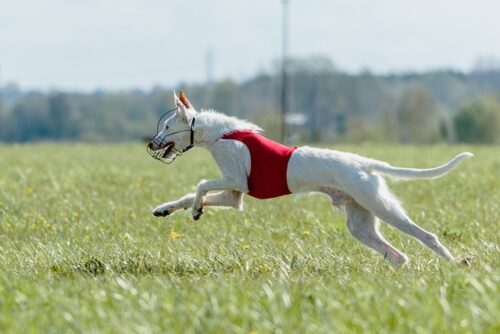Diet is critical for the performance and well-being of canine athletes and working breeds. Whether it’s a Border Collie expertly navigating an agility course, a Labrador Retriever tirelessly training for field trials or a German Shepherd serving in a police K9 unit, each of these remarkable dogs requires a carefully formulated nutritional plan to meet their unique energy demands.
Nutrition for these canine powerhouses isn’t just about filling a bowl; it’s about understanding the balance of proteins, fats, carbohydrates, vitamins and minerals that fuel their endurance and strength. The following tips can help you provide your active pup with the right amount and type of dog food to help them thrive.

Calculate Your Dog’s Specific Energy Requirements
Calculating the energy requirements of active and working dogs is essential for maintaining their health and performance. The first step involves determining the Resting Energy Requirement (RER), the baseline energy intake your dog needs at rest. The formula for RER is 30 × (body weight in kg) + 70.
However, active and working dogs expend much more energy than sedentary breeds. To gauge their energy needs accurately, you need to multiply their RER by a factor corresponding to their activity level. For dogs engaged in moderate work, like hiking with their owner, this factor is around 3. Dogs performing heavy work like sled pulling or hunting may require a factor between 4 and 8.
For example, a Border Collie, a breed known for its high energy and work ethic, weighing 20 kg, has an RER of 670 kcal/day (30 × 20 + 70). For heavy work, like herding sheep for several hours, its energy requirement could reach up to 5,360 kcal/day (670 × 8).
Factors like environmental conditions, diet type, and individual metabolism can influence a dog’s nutritional needs. Regular monitoring and adjustments based on the dog’s health and performance are crucial. Consulting with a veterinarian or a canine nutritionist is always recommended for tailored dietary planning, especially for working dogs with high energy demands.
Choose High-Quality Protein for Muscle Development and Repair
Dogs need protein for muscle growth and repair. This is especially important in dogs engaged in regular physical activity. High-quality protein sources, such as chicken, turkey, beef and fish, provide essential amino acids that are the building blocks for muscle development.
However, it’s not just about quantity; the quality of the protein also matters. Dogs require a balanced diet where protein intake is adequately proportioned with other vital nutrients like fats, carbohydrates, vitamins and minerals.
This balance ensures that while their muscles receive the necessary support for growth and recovery, their overall health is also maintained. For active breeds, choose dog food containing at least 22% protein (dry matter).
Ensure They Get Adequate Fat Content for Stamina and Health
Fats are some of the best ingredients in dog food, especially for sustaining stamina and overall health. They are a dense energy source, crucial for long-lasting endurance in active dogs.
The balance of omega-3 and omega-6 fatty acids is important. Omega-3s, found in fish oils and flaxseeds, support joint health and reduce inflammation, while omega-6s, present in poultry and vegetable oils, are essential for skin and coat health.
When choosing dog foods, look for those that list specific fat sources, like chicken fat or salmon oil, rather than generic animal fats. This ensures your dog is getting the right types of fats in their diet, contributing to their energy levels and overall well-being.
Provide Your Dog With Balanced Carbohydrates for Energy and Digestive Health
Carbohydrates are essential for a working dog’s diet, providing a quick energy source for their active lifestyle. However, selecting the right type of carbohydrates is vital.
While traditional grains are common, grain-free or ancient grain diets are gaining popularity for their digestibility and nutritional value. Ancient grains like quinoa or millet or grain-free options like sweet potatoes and peas offer sustained energy without the potential allergens found in conventional grains. These alternatives provide the necessary carbohydrates for energy and come packed with additional nutrients and fiber, supporting your dog’s digestive health.
Feeding Strategies for Optimal Performance
Careful feeding strategies can help you optimize your dog’s performance, whether working dogs or canine athletes. The right approach can boost their energy levels, endurance and recovery:
- Timing of meals. Feed your dog a balanced meal 3-4 hours before training or competition to ensure they have enough time to digest and convert food into energy. Post-exercise, a small protein-rich snack can aid in muscle recovery.
- Portion control. Regularly monitor your dog’s body condition and adjust portions accordingly. Overfeeding can lead to weight gain, reducing agility and stamina.
- Diet adjustments. During the off-season or as your dog ages, their dietary needs change. Reduce calorie intake in the off-season to prevent weight gain and consider senior-specific diets for older dogs to support joint health and metabolism.
Help Your Pet Achieve Their Potential
When looking for the best dog food for your working dog or canine athlete, prioritize formulas with content, moderate amounts of complex carbs and plenty of healthy fats. Provide your pup with a balanced diet with enough calories to fuel their active lifestyle and watch them enjoy a happy, healthy life.

Leave a Reply